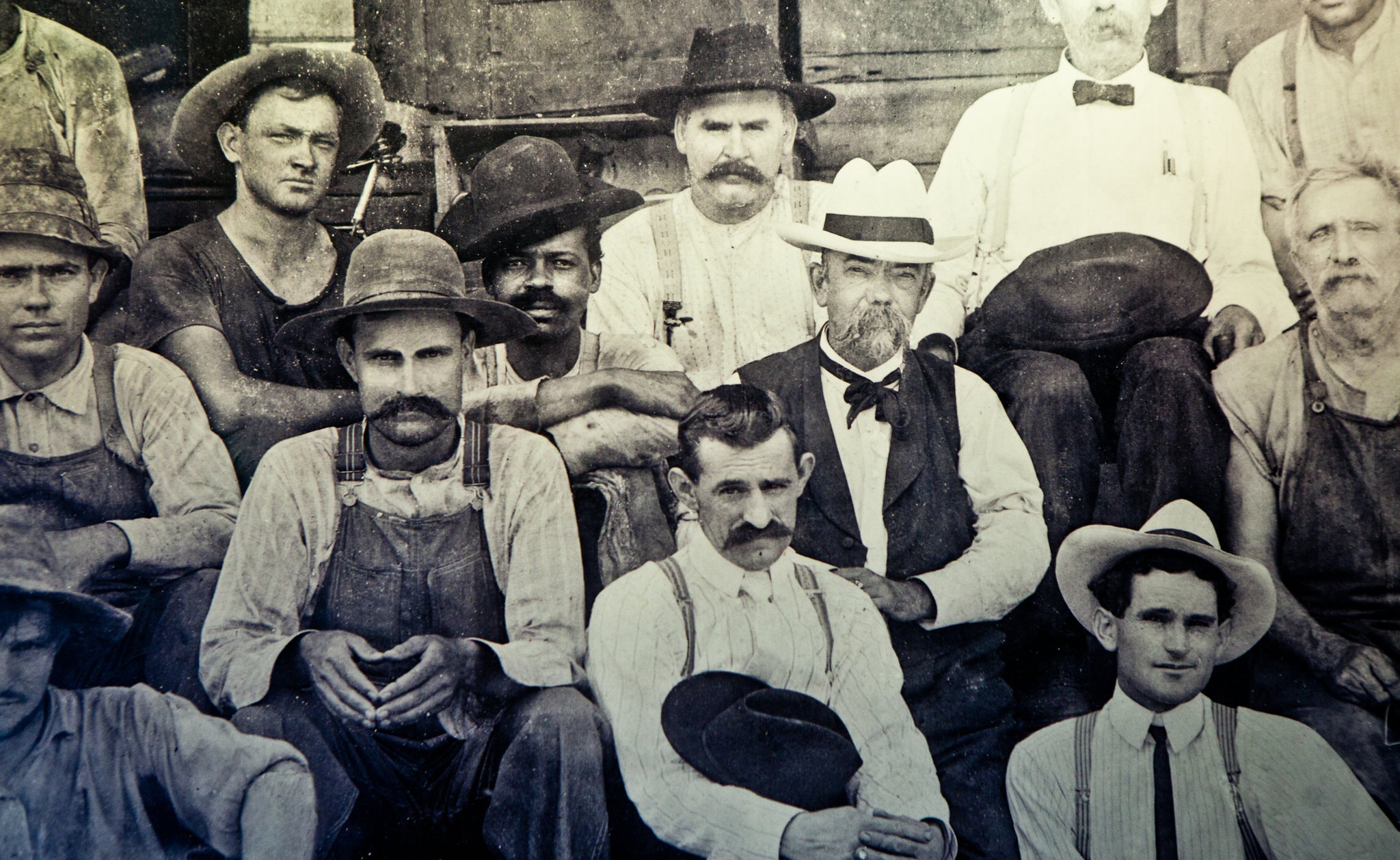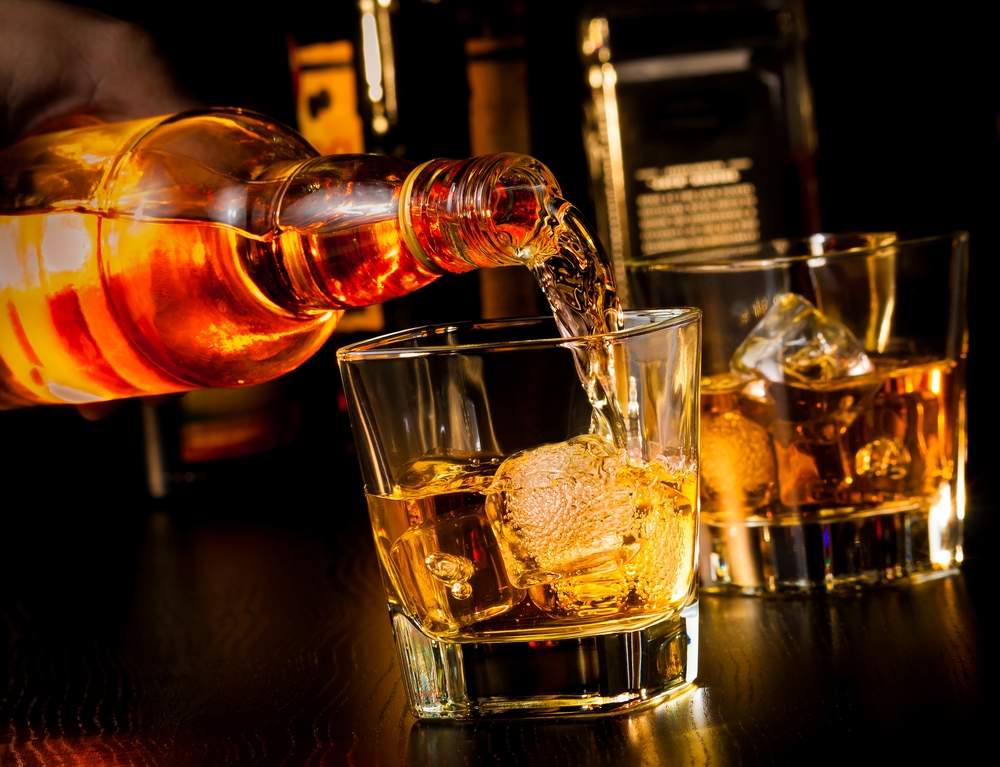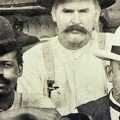
Contributed by Tiffany Floyd, Chicago, Ill., for Whiskey University
ABOVE PHOTO: 1904 IMAGE OF JACK DANIEL; seated to his right is likely George Green, the son of Nathan “Nearest” Green. There is no known photograph of Nearest Green.
Wikipedia: public domain
The story of Nathan “Nearest” Green went mostly untold until a short blurb about an enslaved man named “Nearis’’ was referenced in a 2016 New York Times article.
On its 150th anniversary, Jack Daniel’s used the occasion to reveal to the public that Daniel did not learn distilling from Reverend Daniel Call but was actually taught by Nathan “Nearest” Green. This version of the story was never a secret, but it is one that the distillery has only recently begun to embrace, provisionally, in some of its tours, and in social media and marketing campaigns.
The New York Times article inspired author and entrepreneur Fawn Weaver to set out on a quest to reveal Green’s full story. This encompassed a 12-month research project involving more than 20 historians, archivists, archaeologists, conservators, and genealogists.
Uncle Nearest, as his family and friends in his hometown of Lynchburg, Tennessee called him, was the first known African American master distiller, was born in Maryland around 1820. Around the mid-1800s, his enslavers — a firm known as Landis & Green — “leased” Nearest Green for a fee to local preacher, the Rev. Dan Call. He began working on the farm of the country preacher and distiller in Lincoln County.
Green was known as a skilled distiller who specialized in a process known as sugar maple charcoal filtering – also called the Lincoln County Process. This method is believed by many whiskey and food historians to have been brought in by enslaved Africans, who were already using charcoal to filter their water and purify their foods in West Africa. This process gave Green’s whiskey a unique smoothness.
According to Michael Twitty, a food historian, Green probably would have drawn on generations of liquor-making skills: enslaved Africans brought to America had their own traditions of alcohol production, going back to the corn beer and fruit spirits of West Africa, and many Africans made alcohol illicitly while being enslaved.
“There’s something to be said for the fact that Africans and Europeans were both people in the Southeast who carried with them ancient traditions for making alcohol,” Twitty said.
Years after Nearest Green was working on the Call farm, Jack Daniel, a 7-year-old white orphan, was sent to the Call farm to be a chore boy. He was the tenth child in his family and lost his mother to a sudden illness at the age of four months. He milked and fed the cows and pigs, fetched water from the springhouse, and carried out all the other chores farm hands do. Daniel was not a privileged boy — he was a worker, like Green, who was already proficient at distilling.
Eventually, Daniel became Green’s apprentice and was taught the Lincoln County Process, which differentiates bourbon from Tennessee whiskey, making Nearest responsible for the Tennessee whiskey known today.
According to a 1967 biography, “Jack Daniel’s Legacy,” by Ben A. Green (no relation to Nathan Green), Call told [Nearest] to teach Daniel everything he knew.
“Uncle Nearest is the best whiskey maker that I know of,” the book quotes Call as saying. Although no images of Nearest Green exist, in a photo of Daniel and his workers taken in the late 19th century a photograph shows one of Green’s sons, George, sitting to the immediate right next to Daniel.
In 1865, the 13th amendment was ratified, and Nearest Green agreed to be Jack Daniel’s master distiller as a free man. Daniel asking Green to be his first master distiller was an extraordinary request for such a time and place.
Green’s name, legacy and contribution to whiskey were largely unknown to anyone outside Lynchburg, Tennessee for several decades. However, according to census data, after the Civil War, Green and his family-owned sizable plots of land and were wealthier than many white families living in Lynchburg.

Over time, Jack Daniel moved from the property and took his burgeoning whiskey business with him. Although Green retired and did not go to the new distillery, his sons, Lewis, Eli and George all continued the tradition of making the best whiskey in the area, and went to work with Daniel at his new place. Nearest’s grandsons, Charlie and Ott also went to work for the new distillery.
Altogether, seven generations of Green’s family have worked for the Jack Daniel Distillery and continue to work there to this day. Victoria Eady-Butler, Green’s great-great-granddaughter and former employee of Jack Daniel’s Distillery, noted that there would “never have been Jack Daniel’s made without a Green on the property.”
Daniel and his descendants made a lot of money from their whiskey company over the years. In 1956, the family sold it to Brown-Forman for$20 million – about $190 million in today’s money.
Fawn Weaver was also able to meet Green’s descendants during her research and asked them how they would like to see him honored. They told her that “putting his name on a bottle, letting people know what he did, would be great.”
This gave Weaver the idea to start her own whiskey company that honored Green’s legacy.
By 2019 she had raised $40 million from investors to create Uncle Nearest Premium Whiskey. Later that year she opened the Nearest Green Distillery in Shelbyville, Tennessee. Weaver now serves as CEO of the company, with Victoria Eady-Butler employed as the distillery’s master blender.
“It’s absolutely critical that the story of Nearest gets added to the Jack Daniel story,” Mark I. McCallum, the president of Jack Daniel’s Brands at Brown-Forman, said in an interview, McCallum made plans to put Green at the center of the Jack Daniel’s story line. In a meeting with 100 distillery employees, including several of Green’s descendants, he outlined how the company would incorporate Green into the official history, and shortly afterwards, the company began training its two dozen tour guides.
“We want to get across that Nearest Green was a mentor to Jack,” said Steve May, who runs the distillery’s visitors center and tours. “We have five different tour scripts, and each one incorporates Nearest. I worked some long days to get those ready.”
Another achievement for Weaver and Green’s descendants was when Brown-Forman officially recognized Green as its first master distiller, nearly a year after the company vowed to start sharing Green’s legacy. (Daniel is now listed as its second master distiller.)

















Leave a Comment